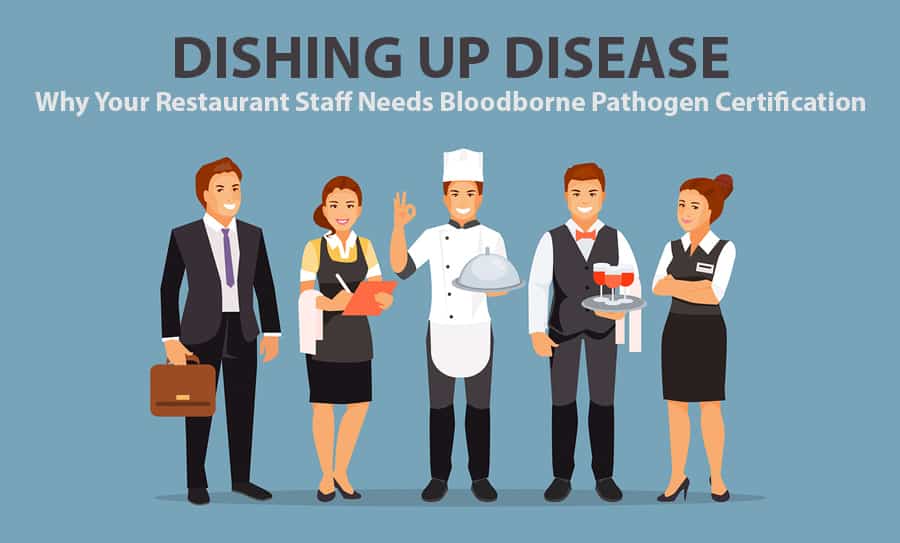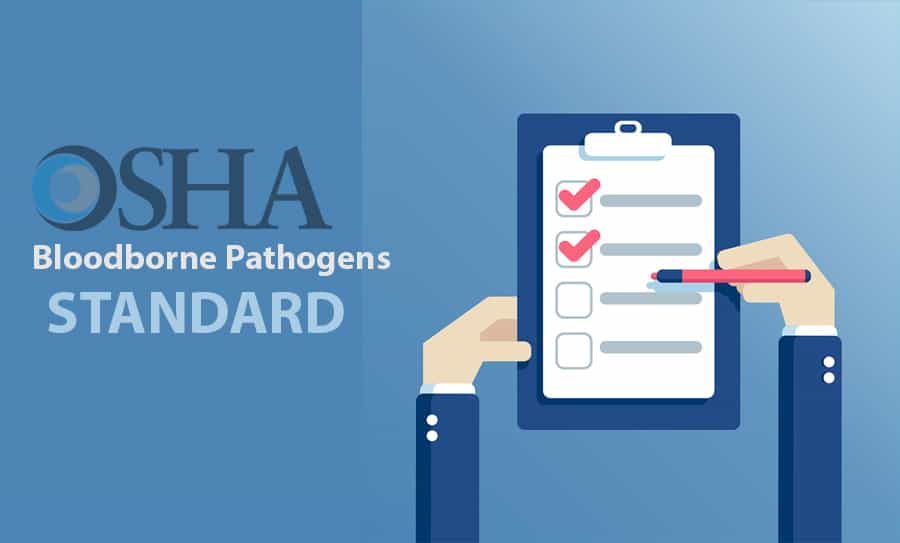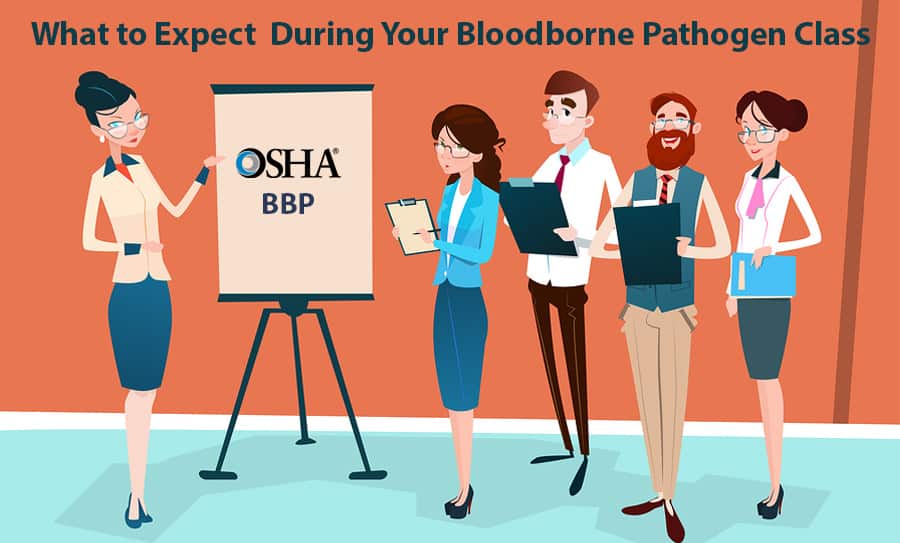Dishing Up Disease: Why Your Restaurant Staff Needs Bloodborne Pathogen Certification
So you’re wondering if your restaurant staff needs bloodborne pathogen certification?
What do you do when one of your employees gets cut with a knife? Do you feel woozy and wake up in a sweat on the floor?
What if a customer breaks a glass, tries cleaning it up, slices their finger open, and creates a bloody mess on the table? You ignore it and hide in the walk-in freezer, right? Let’s hope not!
These things may not happen every day at your restaurant, but they happen every day in somebody’s restaurant. If you have a safety program in place, you and your staff won’t stand around wringing your hands. Or worse, faint on the floor.
Your bloodborne pathogen certification will come in handy!
Oh, you’ve never trained your staff for that? We’d like to say, “no worries,” but we can’t. Instead, we’ve put together all the information about why you need training.
Take a look. Then get ready for school!
Bloodborne What?
If you’re thinking to yourself, “what is a bloodborne pathogen?” you’re not alone. Let’s break it down in simple terms.
Pathogen. Merriam-Webster’s friends at the online Dictionary give a precise definition of the word: a bacterium, virus, or other microorganisms that can cause disease.
Merriam-Webster couldn’t help themselves and used the word in a sentence: “Ticks that carry Lyme disease can also carry other pathogens causing less-common diseases such as anaplasmosis and babesiosis.”
Bloodborne means carried or transmitted by the blood.
The letter e on the end of the word makes it a little less sinister. Thinking about birthing a virus in your blood is creepy. But if you carry the virus, chances are you picked it up and intended no harm.
Don’t like the dictionary’s explanation? Don’t worry, you’ll have many opportunities for exploring the topic when you enroll in a BBP Training course.
A Pathway for Pathogens
This all sounds like hospital talk, so how do bloodborne pathogens end up in restaurants?
Bloodborne pathogens and healthcare workers do make great partners. Blood and other bodily fluids thrive in hospitals and other medical settings. A restaurant is the last place anyone goes expecting an encounter with blood.
However, consider the restaurant environment. Knives, graters, and commercial slicers are tools of the trade. Don’t forget broken glass! What about slips and falls?
Any of these workplace hazards could result in exposure to blood.
Blood exposure can come through human bites, cuts, and abrasions. The eyes, nose, and mouth are another source. Let’s hope the biting humans find other dining places but wounds are normal occurrences in restaurants.
Does bbp certification make more sense now that you’ve imagined your perfectly sane workers creating a bloodbath with a paring knife?
Famous Bloodborne Pathogen Carriers
Your first thought was Typhoid Mary, right? However, typhoid isn’t caused by a bloodborne pathogen. A carrier is simply someone who has recovered from a disease but still carries the bacteria in their body, putting anyone they come in contact with at risk of infection.
The most common diseases caused by bloodborne pathogens are:
- Hepatitis B (HBV)
- Hepatitis C (HCV)
- Human immunodeficiency virus (HIV)
So, rather than using the word carrier it might be more accurate to simply say infected with and leave it at that.
Most humans don’t sit around thinking up new methods of sharing their diseases. There are however people who infect others because they’re thoughtless. Scour the interwebs and you’ll find plenty of stories about patients biting or scratching a caregiver and exposing them to infection.
Restaurant staff doesn’t interact with biters and scratchers – at least not on a regular basis. They do however wipe up blood from floors and countertops if someone gets cut. They also risk coming into contact with blood if they help a co-worker or customer who gets hurt.
If you’ve provided OSHA bbp certification and training, your employees know best practices and can ensure safety for anyone who enters your establishment.
Bloodborne Pathogen Certification Is the Law
No, the police won’t arrest you if you don’t provide training but OSHA may have a few words for you.
For some industries, bloodborne pathogen certification is mandatory. If it’s a requirement and you fail to provide training, you’ll tangle with OSHA. OSHA can shut your business down for non-compliance.
Restaurant workers don’t have the same level of risk of exposure to blood that healthcare workers do but there is still a risk.
OSHA gives employers access to all kinds of information about what types of safety programs and certifications they require for every industry. In addition, all employers must adhere to general safety and health standards. OSHA believes all employees benefit from training.
Knowing the number of times your employees use knives, slice meats, scald themselves, or handle broken glass, why wouldn’t you arrange for the bbp training?
What Do Employees Learn from a Course?
Most managers prefer an online course format. The staff enjoys working at their own pace and managers appreciate not having the entire crew unavailable at the same time.
After course completion, you and your staff should understand bloodborne pathogens, why they’re dangerous, and how protective practices work. They will know the difference between being reactive and proactive.
Reactive employees panic when they see blood, which causes poor decision making. They may touch a contaminated knife or cleaning cloth with bare hands. Proactive workers know the importance of wearing gloves when handling blood or other body fluids.
Education is important but prevention saves lives. The point of any bbp course is training staff so they’re protected from potentially deadly diseases caused by exposure to blood in the workplace.
Is Training a One-Time Deal?
In a word – no. OSHA requires annual bbp training. Most people need reminders on a regular basis of steps needed when emergencies happen. You renew CPR certification every year and this is no different.
Innovation is a big part of annual training. New protective methods and better ways of delivering course content are always in play behind the scenes. Offering staff the most current information is another way you help keep them safe.
Time for School
The importance of workplace safety can’t be understated especially when dealing with risks that could affect life and livelihood. When you choose bloodborne pathogen certification for your restaurant staff, you protect your employees, yourself, and your bread-and-butter, your customers.
Ready for school? BloodborneTraining.com is ready for you! Learn more here and set your employees up for a safe work experience.





